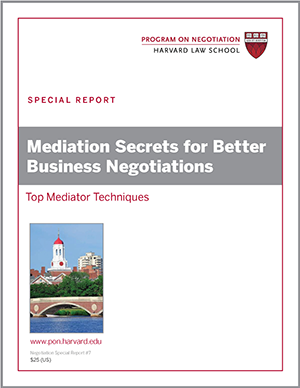
How does mediation work in practice? As compared with other forms of dispute resolution, mediation can have an informal, improvisational feel. Mediation can include some or all of the following six steps, writes Kimberlee K. Kovach in The Handbook of Dispute Resolution (Jossey-Bass, 2005):
1. Planning. Before mediation begins, the mediator helps the parties decide where they should meet and who should be present. Each side might have lawyers, coworkers, and/or family members on their team, depending on the context.
2. Mediator’s introduction. With the parties gathered together in the same room, the mediator introduces the participants, outlines the mediation process, and lays out ground rules. She also presents her goal for the mediation—for example, to help the parties come to agreement on the issues under dispute and improve their relationship.
3. Opening remarks. Following the mediator’s introduction, each side has the opportunity to present its view of the dispute without interruption. In addition to describing the issues they believe are at stake, they may also take time to vent their feelings.
4. Joint discussion. After each side presents its opening remarks, the mediator and the disputants are free to ask questions with the goal of arriving at a better understanding of each party’s needs and concerns. Because disputing sides often have difficulty listening to each other, mediators act like translators, repeating back what they have heard and asking for clarification when necessary. If parties reach an impasse, mediators diagnose the obstacles that lie in their path and work to get the discussion back on track.
5. Caucuses. If emotions run high during a joint session, the mediator might split the two sides into separate rooms for private meetings, or caucuses. Often, but not always, the mediator tells each side that the information they share in caucus will remain confidential. The promise of confidentiality can encourage disputants to share new information about their interests and concerns.
6. Negotiation. At this point, it’s time to begin formulating ideas and proposals that meet each party’s core interests—familiar ground for any experienced negotiator. The mediator can lead the negotiation with all parties in the same room, or she can engage in “shuttle diplomacy,” moving back and forth between the teams, gathering ideas, proposals, and counterproposals.
When putting together your settlement proposal, professor Stephen B. Goldberg of Northwestern University recommends that you ask the mediator for her advice. Her conversations with the other side have probably given her knowledge of its interests that you can use when packaging your proposal.
About 80% of dispute mediations lead to resolution, according to Goldberg. Depending on the complexity of the issues, mediation might last mere hours, or it could take days, weeks, or months to resolve. Some resolutions will truly be “win-win”; others will be just barely acceptable to one or both sides—but better than the prospect of a continued fight or court battle.
If the parties come to consensus, the mediator will outline the terms and may write up a draft agreement. If you fail to reach agreement, the mediator will sum up where you have left off and may engage you in a discussion of your nonsettlement alternatives.
Adapted from “Make the Most of Mediation,” first published in the Negotiation Briefings newsletter.
Related Mediation Posts:
Dispute Resolution: How Mediation Unfolds
Navigating the Mediation Process
Article: Negotiation and Nonviolent Action: Interacting in the World of Conflict
Choosing a Mediator
What are the Three Basic Types of Dispute Resolution? What to Know About Mediation, Arbitration, and Litigation
Originally published on January 26, 2010.






I’m a mediator based in London in the UK and the process outlined in this article is certainly familiar to most civil and commercial mediators that of a problem solving model. It follows the journey from Mediator’s introductions, then onto opening remarks (more commonly referred to these days as position statements – despite trying to move away from any litigious language), then onto joint discussions (we call it exploration in the UK). Caucusing isn’t necessarily a step in the process although many commercial mediators assume it is and move swiftly from opening remarks to caucusing – choosing to explore the issues independently with the parties. Whilst I think this approach serves a purpose in say commercial negotiations I do question it’s usefulness for other disputes. I also question to what extent this approach is consistent with the principles of party self-determination.
There are other models of mediation that claim (and seem to be) more aligned with the values of self determination. Transformative mediation is one, developed by Professor Joseph Folger and his colleague (outlined in the their book The Promise of Mediation). In Transformative mediation the process is more organic and fluid and the process (and direction of the conversation) is determined by the parties, the job of the mediator is to invite compassion and support conflict interaction.
There’s a very informative interview with Professor Folger on the values of self determination in mediation Professor Folger describes the transformative mediation approach and how it differs from the approach described in this article. It’s well worth watching.
Thanks
Thank you Aled!
Stephen Goldberg says that About 80% of dispute mediations lead to resolution. This estimate should be qualified.
I mediate real estate disputes for both the American Arbitration Association and the Los Angeles County Superior Court. Court mediations are mandatory, whether the disputants are interested in going through the process or not. As a result, less than half are resolved successfully.
The American Arbitration Association mediations are entered into voluntarily, thus resulting in a high percentage of resolutions, which is similar to the one Goldberg cites.